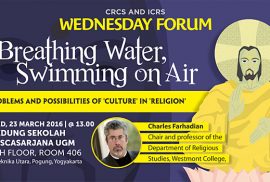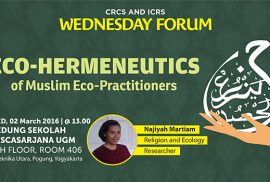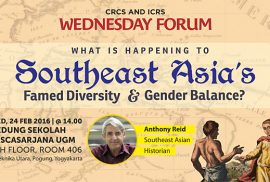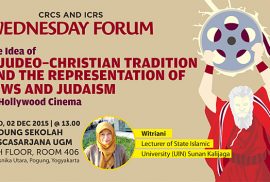
Abstract
One of the great debates among religious believers is about the relationship between their religion and culture. Is culture an obstacle to religion or is culture its vehicle? This lecture explores the cultural issues within Christianity and the problem and possibilities of the concept of culture to understanding religions. Related themes of history and globalization will be considered.
Speaker
Charles Fahardian, Ph.D is chair and professor of the Department of Religious Studies, Westmont College, Santa Barbara, CA. He has investigated diverse themes such as nation making, globalization, and worship. He teaches courses in the world religions and Christian mission. He studied at Seattle Pacific University (B.A), Yale University (M.Div), and Boston University (Ph.D)
Wednesday Forum News

Abstract
Speculating what Paradise looks like is one of the longest continuous discussion of an imagined landscape. Where is it located? How does this promised eternal space looks like?
This long conversations about the physicality of Paradise is an attraction for me as a landscape architect as a way to reflect how we imagine nature and how this spiritual (or sometimes voyeuristic or super terrestrial) visualisations is defined by the real world, our own culture, new scientific discoveries, or as ways to search for lost tradition. With this lecture, let us go for a “walk” – sometimes factual and sometimes with our own imaginations – looking at various paradises through paintings, maps and films.
Speaker
Faiz Bin Zohri is a landscape architect driven by the interconnections of urban public spaces, landscapes, traditions, ecology and water. He has been involved in various urban, landscape and public art installation projects of various scales in the Netherlands and Singapore.

Abstract
Contemporary Muslim discourse on Islam and ecology displays a strong normative approach which deduces its views on Islam and environmental issues from the main textual sources of Islam. However, recent works on the ecological practices of Muslim individuals and communities are showing that such practices are not merely implementations of text-based norms; rather, they also engender new arguments and understandings. Putting attention only to normative debates tends to ignore the fact of pluralism within Islam and different ways of reading the Islamic texts, and the diversity of Muslim eco-practices as well. Following an examination of this discourse, this study focusses on how one Muslim eco-practitioner has developed, justified, and defend eco-friendly practices, and his ideas about Islam and ecology are lived through his practices. It shows that ecological practices not only apply normative texts, but also function in the formation of “Islamic views of nature” and “Islamic environmental ethics”. Finally this presentation also produces different narratives on Islam and ecology which need to be acknowledged and may prove more inspiring for advocacy than the apologetic ones.
Speaker
Najiyah Martiam earned her Bachelor’s degree in Agricultural Technology from Gadjah Mada University (UGM). After spending 4 years working on reproductive health issues, she came back to UGM to study for her Master’s degree in religious studies at the Center for Religious and Cross-cultural Studies (CRCS) where she currently works as public education staff. She is also researching Islam and ecology, and practising permaculture with her community. Her interests include religion and science, religion and ecology, Sufism and women’s spirituality, and music and spirituality.
Abstract
Among Southeast Asia’s many distinctive features, some would say stereotypes, there are two which I have helped to build. The first is its great diversity of language, religion, mode of production and political organization, where ‘empires failed to unify’ and stateless hunter-gatherers may still be found. The second is the economic autonomy of women, who had their own secure share in production (planting, harvesting, textiles, pottery, marketing) and therefore an almost uniquely strong position in sexual politics. As an historian, I was excited to demonstrate both features in the era before modernity entranced the region around 1900. Today’s students are entitled to ask, ‘Then what happened?’ Does modernity require nationalist homogeneity and patriarchy? Or was the region seduced by a peculiar ‘Victorian’ model of colonial modernity that could never really succeed in such a context?
Speaker
Anthony Reid is a Southeast Asian historian, once again based at the Australian National University after serving as founding Director of the Center for Southeast Asian Studies at UCLA (1999-2002) and of the Asia Research Institute at NUS, Singapore (2002-7). Since 2004 he has been increasingly interested in the impact of natural disasters on Southeast Asian history. His books include The Contest for North Sumatra: Aceh, the Netherlands and Britain, 1858-98 (1969); The Indonesian National Revolution (1974); The Blood of the People: Revolution and the End of Traditional Rule in Northern Sumatra (1979); Southeast Asia in the Age of Commerce, c.1450-1680 (2 vols. 1988-93); An Indonesian Frontier: Acehnese and other histories of Sumatra (2004); Imperial Alchemy: Nationalism and political identity in Southeast Asia (2010); To Nation by Revolution: Indonesia in the 20th Century (2011); and A History of Southeast Asia: Critical Crossroads (2015).

ABSTRACT
Hate speech is one of the factors contributing to sectarian and ethnic conflict. It typically includes social/psychological processes of dehumanization and demonization that define others as less than human and archetypes of evil. Often others are described as existential threats to the very existence of the speaker’s community. It is used to incite or justify violence, sometimes rising to the level of genocide. It is nearly often entirely inaccurate.
Hate speech is an under theorized mode of contentious discourse. It is easy to recognize and difficult to define precisely. In this paper I located hate speech within a four-point typology of contentious discourse: 1. Dialog concerning religious differences; 2. Unilateral condemnation of the beliefs and practices others; 3. Dehumanization and demonization of others and implicit justification of violence; 4. Explicit provocation of violence. For examples I rely primarily on the violent rhetoric of the Indonesian Islamic Defenders Front.
Dehumanization and demonization are the psychological processes that distinguish between civil discourse and hate speech. Levels 1 and 2 are critiques located within the limits of civil discourse because they do not implicitly or explicitly threaten others. Levels 3 and 4 are hate speech. They make symbolic associations that are inherently threatening.
Some forms of hate speech are universal or nearly so. Among these are the description of others as animals, evil, heretics and/or of engaging in “inappropriate” sexual conduct. Others are culturally or religiously specific. More research is required to understand the semantics of hate speech and how it transcends religious and ethnic boundaries.
There is an inevitable contradiction between defending freedom of speech, as guaranteed by Article 19 of the Universal Declaration of Human Rights,and protecting people, usually minorities, from the psychological harm hate speech causes and the risk of physical violence it exposes them to.Legal restrictions do not eliminate hate speech; they only drive in from the public sphere. Most laws restricting hate speech were drafted long before the Internet and social media existed. Now, they are largely ineffective. Countering hate speech requires concerted effort by religious and political leaders and netizens across a range of media, including those used most frequently, including social media, by extremists who promote it. In this presentation I rely on examples from Front Pembela Islam (Islamic Defenders Front/FPI).
SPEAKER
Mark Woodward is Associate Professor of Religious Studies and is also affiliated with the Center for the Study of Religion and Conflict at Arizona State University. His research focuses on religion-state-society relations and religion and conflict in Southeast Asia. He is author of Islam in Java. Normative Piety and Mysticism in the Sultanate of Yogyakarta, Defenders of Reason in Islam (1989)and Java, Indonesia and Islam (2010) .He has published more than fifty scholarly articles in the US, Europe, Indonesia and Singapore, many co-authored with Southeast Asian scholars. He his currently directing a trans-disciplinary, multi-country project on counter-radical Muslim discourse.
Abstract
American Jews have long been prominently involved in the American media and film industries, so much so that some commentators have even said they are ‘the backbone of film production in America’. This position has indeed given opportunities for Jewish Americans in the industry to play a prominent role in shaping the business including issues of how Jews and Judaism are represented in film and other media. However, depictions of Jews and Judaism in American movies have changed according to political and cultural conditions. After World War II, a new formula emerged on the silver screen. The reframing of American religious identity as “Judeo-Christian” encouraged directors and producers who were Jewish to promote the concept of America as a Judeo-Christian nation as a response to ongoing anti-Semitism in America. Examining Biblically-themed movies such as The Ten Commandments and Ben Hur-A Tale of the Christ, this presentation intends to explore the connection between the idea of a “Judeo-Christian” tradition and the acceptance of Jewish Americans and recent immigrants by American society. The portrayal of Jews in these movies is interesting to discuss here, not only because Jews and Christians are depicted in the same framework of the Hollywood movie, but also because of the underlying politics of representations.









